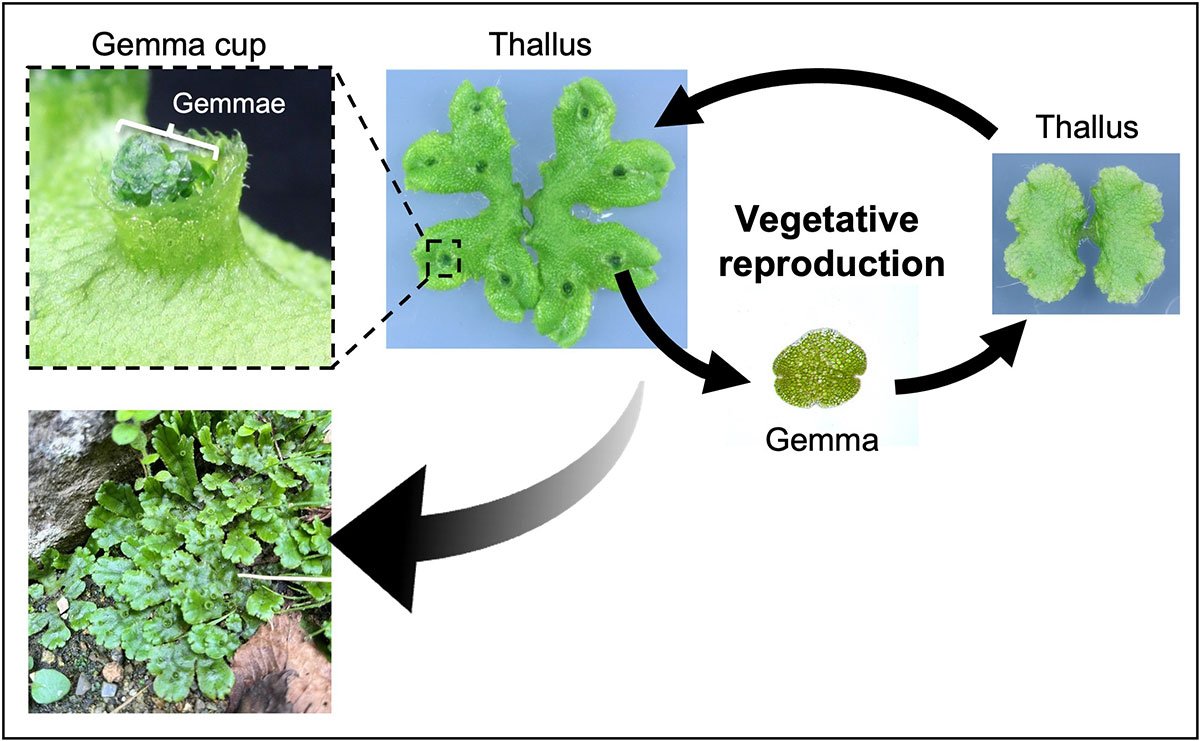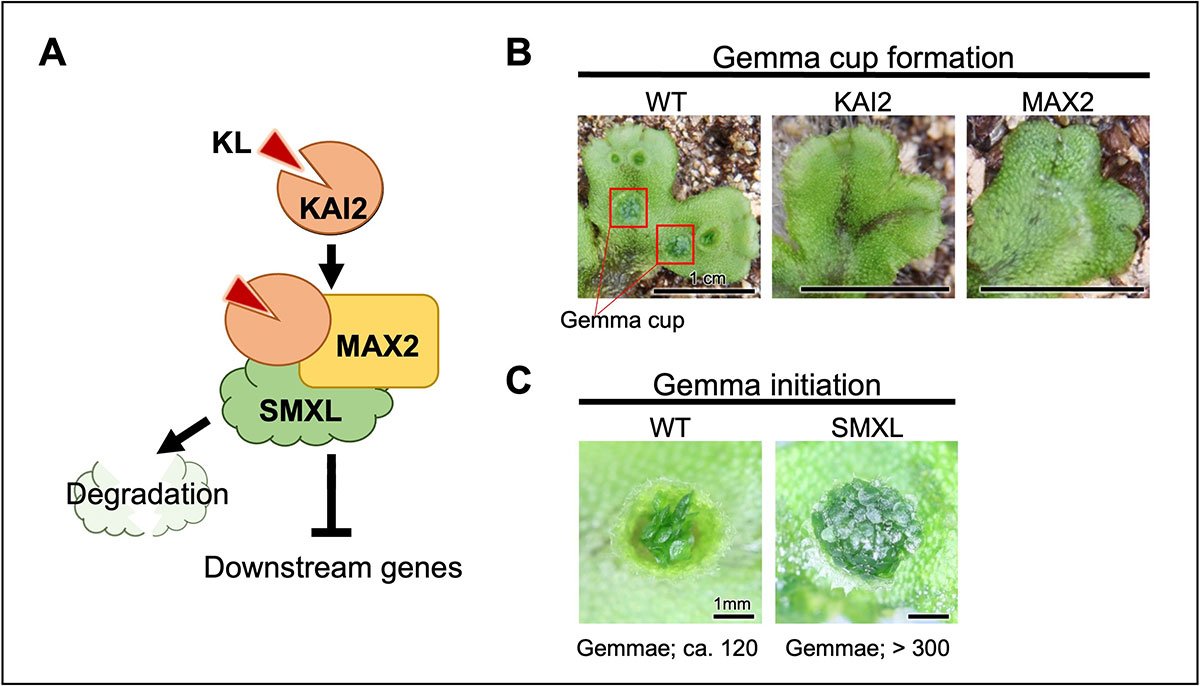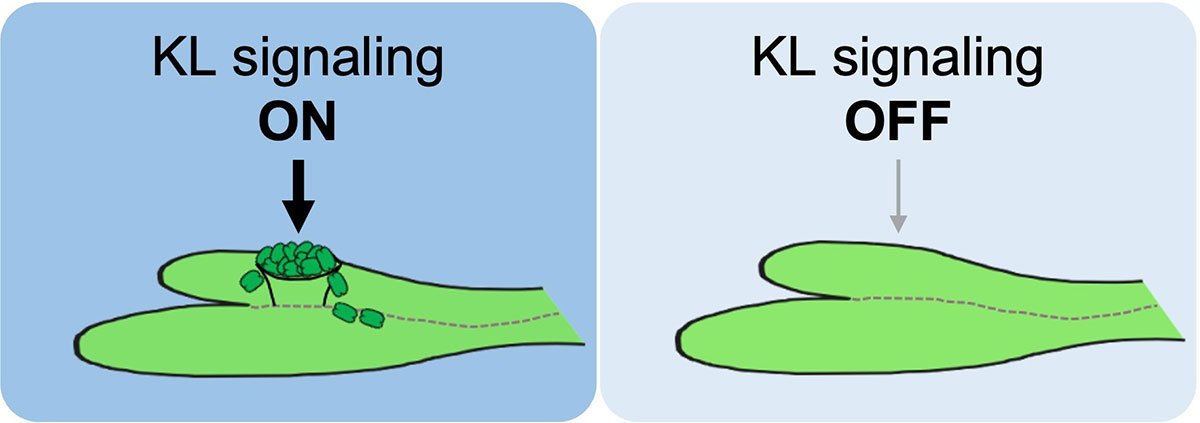Asexual, or vegetative, reproduction in plants is controlled by environmental conditions, but the molecular signaling pathways that control this process are poorly understood. Recent research suggests that the KAI2-ligand (KL) hormone is responsible for initiating and terminating the production of gemmae, or genetically identical plantlets, on liverwort plants based on the presence or absence of specific environmental factors.
A team of leading scientists from Tohoku University designed a research study to investigate the hormones and signaling pathways associated with vegetative reproduction in the liverwort plant Marchantia polymorpha. Through a series of gene knockout (loss of function) experiments, the researchers demonstrated that the MpKARRIKIN INSENSITIVE2 (MpKAI2)-dependent signaling pathway initiates gemma cup, the structure that surrounds gemmae plantlets, and gemmae formation in liverwort plants, and that KAI2-dependent signaling, initiated through KL hormone binding, determines the total number of gemmae produced in a gemma cup. The team additionally observed that switching off KAI2-dependent signaling in the liverwort plant stops gemma production through the accumulation of MpSMXL, a suppressor protein.
The team published the results of their study on March 1, 2023 in the journal Current Biology.
"We discovered that the plant hormone KAI2-ligand, KL, is a gemma initiation hormone, and the efficiency of vegetative reproduction is regulated by modulating KL signaling according to environmental conditions," said Junko Kyozuka, one of the research paper authors and professor at the Graduate School of Life Sciences at Tohoku University. Interestingly, the KL hormone has yet to be identified, but researchers have inferred its presence based on its ability to bind and activate the KARRIKAN INSENSITIVE2 (KAI2) signaling pathway.

Through their research, the team discovered that normal, wild-type liverwort plants consistently produce the same number of gemmae given the same environmental conditions, suggesting a genetic basis for this trait. The researchers discovered that KAI2-dependent signaling, initiated by KL binding, starts the process of gemma formation by breaking down the MpSMXL suppressor protein. Once the proper number of gemmae is produced, KAI2-dependent signaling is turned off, and the MpSMXL suppressor protein accumulates again, turning off gemma formation.
"Because vegetative reproduction is widespread in plants, this discovery also elucidates the origin of vigorous growth pattern[s] of plants," added Kyozuka. Importantly, the team also revealed the direction that gemmae are initiated in the gemma cup, which starts from the inner region of the gemma cup and moves out to the periphery.

While the current study has answered many important questions related to vegetative reproduction in the liverwort plant, many questions remain. The identity of the KL hormone remains unknown, and the environmental conditions responsible for KL regulation, and thus KAI2-dependent signaling, remain a mystery. The research team experimented with liverwort growth medium that lacked potassium (K), nitrate (N) or phosphorus (P) to observe the effect of nutrient deprivation on gemmae formation, but no effect was seen on normal, wild-type liverwort plants. The team plans to design future studies to determine the environmental factors that influence KL regulation and their individual effects.
The mechanisms that dictate when gemma formation stops in liverwort plants also remain unknown. The research team removed gemmae from gemma cups that were actively producing gemmae and found that removal of gemmae didn't affect the timing of gemma initiation termination (roughly 10 days) or the total number of gemmae formed in the cup. This result suggested that the timing, rather than the number of gemmae in a gemma cup, is more likely to determine when gemma initiation ceases. However, the researchers could not rule out a role for gemmae quantity in the termination of gemmae initiation. The team plans to more fully investigate both hypotheses in future studies.
Other contributors include Aino Komatsu, Kyoichi Kodama, Yohei Mizuno and Mizuki Fujibayashi from the Graduate School of Life Sciences at Tohoku University in Sendai, Japan; and Satoshi Naramoto from the Graduate School of Life Sciences at Tohoku University in Sendai, Japan and the Department of Biological Sciences at Hokkaido University in Sapporo, Japan.

- Publication Details:
Title: Control of vegetative reproduction in Marchantia polymorpha by the KAI2-ligand signaling pathway
Authors: Aino Komatsu, Kyoichi Kodama, Yohei Mizuno, Mizuki Fujibayashi, Satoshi Naramoto, Junko Kyozuka
Journal: Current Biology
DOI: https://www.sciencedirect.com/science/article/abs/pii/S0960982223001628






